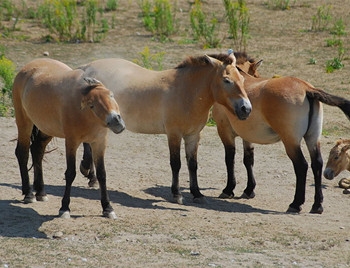
But there is a problem with the idea that hunting caused the mass extinction. Mammoths were not the only animals to disappear.
但是狩猎带来的一个问题是大量物种的灭绝,猛犸象并不是唯一的消失的动物。
Camels survived for millions of years in North America, but disappeared around the same time as the mammoths. Wild horses first evolved here and became dominant grazers. Yet they, too, vanished soon after the Ice Age ended. But there’s little evidence to suggest that humans hunted horses or camels. This seems to go against the hunting argument.
骆驼在北美洲生存了上百万年,但是也和猛犸象大约同一个时间消失了,野马首先在这里代代繁衍,并主宰了这里的草地,然而不久他们也随着冰河时代结束而灭绝了,但是几乎没有证据可以表明人们狩猎过马匹和骆驼,这似乎与狩猎规则不符。
So what else would have triggered such large-scale extinctions?
那么还有其他的因素可以触发这种大规模的灭绝吗?
The other major possibility is climate change. The end of the Ice Age was a turbulent, erratic period. In some areas, rain patterns were shifting, bringing moisture back to dry landscapes and turning grassland into forest.
另一种主要的可能性是气候的变化,冰河时代末期是个动荡流离的时期,在一些地区,降雨发生了改变,很多干燥的地区变得湿润,草地变成了森林。
Other regions of the continent were plunged into prolonged periods of draught. For grazers such as horses, this led to a massive change in habitat, one they were not flexible enough to overcome.
北美大陆的其他地区仍然陷于长期的干旱,像野马这样的食草动物,它们的栖息地发生了大规模改变,而他们并没有足够的能力来适应这些改变。
As the land dried out, many grass eaters disappeared. We may never know for certain what killed off most of the larger animals at the end of the Ice Age. We do know that there was a time of coincidence—people were arriving just as the climate was in a state of change. Both may have played their part. Whichever was responsible, more than 70 species vanished for good, but some large animals did survive and still live here today.
随着陆地的干旱,大量食草动物灭绝,冰河时代末期为什么大多数大型动物灭绝,这对于我们来说,可能永远是个不解之谜。但我们可以肯定的是一个时间巧合,人类达到大陆的时候也正是气候改变的时候。两者可能都起了一定的作用。不管到底谁是动物灭亡的罪魁祸首,70多个物种都永远地灭绝了,但是如今仍有一些大型动物存活至今。
英文文本来自普特英语,译文属可可原创,仅供学习交流使用,未经许可不得转载。












